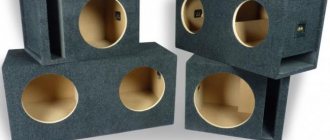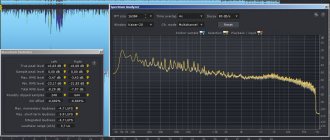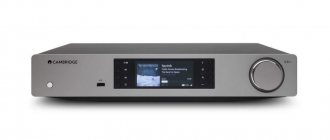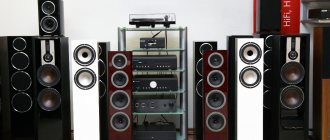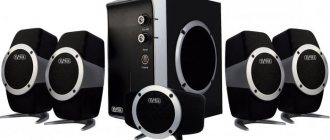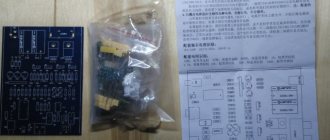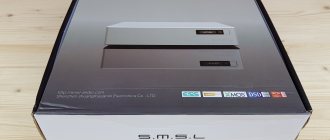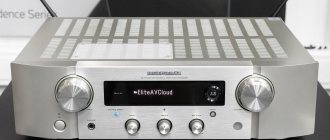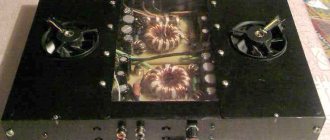There was not an ounce of editorial direction in compiling the technique for this material. This text was created through my own experience while solving a seemingly simple task that took more than one month. I want to attach a cool USB DAC to my laptop that costs up to a thousand dollars!
Let us denote the introductory situation. The main audio stream in my system is pulled out and in via USB between the Tiny MPD based streamer and an external USB converter. If I want to listen to something from my laptop on speakers, I have to transfer this USB cable to it, which I absolutely don’t want to do. How to integrate a laptop into the main system and not lose quality?
The most obvious and investment-free solution is to connect the HDMI cable from the laptop to the AV receiver. Perhaps this idea is where the content of the material will end for some. The trouble is that Windows itself is not very flexible for this type of sound transport. When installing HDMI, the operating system hardcodes it wherever possible. While we prefer to keep the external audio interface only in the music player. Well, all other sounds are output to external speakers or headphones. So there was nothing left to do but look for a suitable USB DAC for the laptop. The first step on this path was AudioQuest Dragonfly Black.
AudioQuest Dragonfly Black: Springy Sound
The device is described in sufficient detail in one of the previous Stereo materials. Let's summarize everything important here. I am a corpulent man, and small forms always evoke sympathy. A tiny device the size of half a little finger changes the color of the logo depending on the signal sampling. Very nice! The price of this DAC turned out to be the lowest in a series of devices that we had to test later.
The Dragonfly easily drove my Ultimate Ears Triple Fi10 low impedance armatures and Audio-Technica ESW-10 overhead hi-fi model. Directly from the laptop, the Ultimate Ears Triple Fi10 sound too crooked and muffled, not only because of the mediocre built-in Realtek sound system, but also because of the high impedance at the mini-jack output. Audio-Technica on a laptop is more confident with its 64 Ohms, but connecting them to a smartphone is already useless. Dragonfly Black easily handled these two, plus it has low power consumption, so you can connect it to your phone via an adapter. However, carrying such a construct in your pocket is not very convenient - every movement of the contacts threatens to disrupt synchronization and stop playback.
So, with my headphones, Audioquest produced a quite peppy and springy sound. Nevertheless, attempts to bring music to large speakers did not arouse enthusiasm. It’s not that I don’t like the Saber 9018 chip, but it’s obvious that the Dragonfly Black micro-hardware performs adequately in portable forms. Everything was fine paired with the Dali Katch, but the floor-standing speakers definitely needed a more neutral and precise source.
In addition, Audioquest was upset by the limitation of the upper sampling frequency of 96 kHz. This year, the Dragonfly Black and Red DACs, after an upgrade, gained MQA support, which is not really found anywhere except the Tidal application. So I looked at the next DAC among devices where format compatibility has been resolved with reserve.
Review of SMSL Sanskrit 10th MKII. AK4493 for everyone
Intro
For the first time in my review, I have a purely DAC - a type of device that I was previously quite skeptical about, because everyone knows that the amplification path is much more significant - it’s not for nothing that it’s the amplification modules that change in players. But in practice it turned out that a “discrete” DAC significantly affects the sound signature of the circuit, and sometimes can correct its key shortcomings. This is exactly what happened with my “audiophile” combination, the sound of which, before the appearance of the second Sanskrit in its composition, clearly lacked energy and punch. Well, now is the time to get to know the device in more detail.
Equipment
A cardboard package of moderate dimensions, in addition to the main unit, gives the buyer a set of waste paper, a compact remote control, a USB cable “clad” in white silicone insulation, and a set of self-adhesive legs. It is noteworthy that when connected to a PC, the device is powered via USB, so there was no place in the package for an additional power adapter.
Design. Buttons and connectors
The second generation of the DAC completely copies the design of its predecessor - with all its advantages and all its flaws. True, the only thing that can be criticized for the appearance of the product is the easily soiled aluminum, which is also not so willing to part with fingerprints. In all other respects, the device pleased me: its successful, time-tested form; optimal dimensions; a discreet shade (I got black), the absence of any decor and all sorts of huge LEDs, screens and inscriptions. In practice, we have only one key and a miniature screen displaying the current sampling frequency. By the way, there are actually two displays, but in reality only one works, depending on the orientation of the DAC in space.
As for the set of connection interfaces, the situation here is very favorable, because, despite the affordable cost, Sanskrit 10th #2 received not only USB, but also digital coaxial and optical connectors, which significantly expand the scope of application of the device. The analog set is represented only by an RCA output pair - the day has not yet come when $150 devices have balanced XLRs. There is also a micro-USB for powering from external power sources, which will be needed, for example, when connecting the SMSL Sanskrit 10th MKⅡ to a TV.
Circuitry and software
The first Sanskrit was equipped with the extremely popular AK4490 DAC chip, while the second generation is equipped with a more current chip produced by the same Asahi Kasei, this time labeled AK4493EQ (PCM 32/768, DSD 512). And this is a breakthrough, because even the AK4490 was usually used in higher-cost solutions, but here is a completely new chip and, moreover, inside a product that costs less than $150. In general, long live competition. In addition, Sanskrit 10th MKⅡ can boast of the presence of Japanese clock generators, capacious film capacitors, an up-to-date XMOS USB buffer, as well as a fairly powerful amplification path that produces a respectable 2.2 Vrms. By the way, the circuit design does not allow you to adjust the level of the output signal, that is, at the output we have a purely linear signal.
Sound
It’s worth mentioning right away that I tested the Sanskrit 10th MKII paired with a Denon DRA-F102 CD player/amplifier combination, as well as with an SMSL SP200 headphone amplifier. Looking ahead, I will say that the DAC showed itself in the best light in conjunction with the Denon, because my old sound card (Focuswright) did not provide enough exhaust to drive the speaker system normally. Sanskrit 10th MKII (in turn), thanks to the high value of the output “current”, made my speakers sound almost in a new way: with more biting attack and energy in the midrange, with brighter, extended and detailed highs, as well as with more textured, booming and less muddy bass. In general, this presentation is best suited for working with genres such as rock, blues, metal and some branches of jazz, while heat-tube compositions may lack imposingness, melody and, let’s say, honey-like consistency. As for the “behavior” of the DAC in conjunction with the audiophile headphone amplifier SMSL SP200, the picture here is no longer so clear, because, as for me, its sound paired with Sanskrit has become a little less noble and melodic, that is, more punchy and loud, and therefore tasteful.
Results
SMSL Sanskrit 10th MKII is an excellent inexpensive DAC with a neat design that will make everything and everyone sound different, because it is obvious that S.M.S.L engineers know how to select, solder and configure, simultaneously evaluating their work without unnecessary pathos and vanity. In general, if you need a productive DAC with a feed that tends to be “light,” then the second Sanskrit is what you need. Moreover, thanks to the presence of three digital signal reception channels, you can experiment with the device by connecting it to a TV, various types of network players, active speakers and other devices that work with sound. All the best.
Chord Mojo: we meet by clothes
If AudioQuest was cute, then Mojo is simply handsome! An anodized aluminum case with engraving, multi-colored balls light up, indicating the sampling and volume level - you just want to take it and believe that the sound and other abilities of Mojo will be truly crazy. After all, the reviews of Mojo owners on the forums really look written on the verge of hysteria.
The price relative to Dragonfly Black here has increased more than five times - go for a walk! In general, this is considered Chord’s cheapest budget model, but with the size of two boxes of matches, one must assume that Chord’s typical prices per square centimeter remain the same.
Despite the rich equipment with inputs, the device leaves a contradictory impression. After something useful there is bound to be an annoying inconvenience. Because the Mojo's gate array and amplification stages require much more power, it comes with a battery that can last for several hours. It’s fine for a walk, but in a hospital the battery must be recharged all the time. However, this cannot be done via the micro USB input, through which the actual audio signal is received. The developers are so concerned about the cleanliness of the power supply that the device uses another micro USB input with a controller for charging, which quietly hisses and warms up the entire device in charging mode. Thus, in the desktop version, as many as three cables will be connected to Chord Mojo.
The Mojo has two analog outputs - you can connect headphones to one, and something else to the other - a second pair of headphones, or a cable leading to an amplifier. The coaxial input and analog outputs are implemented on mini-jacks, so in stationary systems you will need adapters to RCA. You can also connect smartphones or tablets to Mojo and output Hi-Res audio from them.
As you know, Chord components do not contain converter chips; everything is done by the FPGA designer. In this case, the upper PCM frequency is declared up to 32 bit / 768 kHz and DSD128. The latter will be shown in one white color with DSD64; individual illumination is provided for the remaining frequencies. It also determines the volume level. Double-clicking both balls puts the device into linear mode, although in reality this is simply matching the stated output voltage level. For Chord it is traditionally higher than 2 Volts, so my advice: when connecting to a hospital, instead of the line level (blue color), it is better to make it a little smaller - green. Let the amplifier pump the rest, and the battery will not be consumed as much.
If you know nothing at all from the world of high-quality audio, then the headphones perform simply phenomenally on Mojo. Everything is so dense, with excellent control, and it rolls and rolls, like on a good cassette player. However, I have at my disposal not only the Dragonfly Black, but also the glorious Sony PCM-D100 recorder, to which the Mojo is still slightly inferior. Sony's sound signature seemed more thoroughbred and refined to me. As for comparison with Dragonfly Black, Mojo is certainly more powerful, but in terms of quality we cannot say about a striking (at least not fivefold) superiority in sound.
It is, of course, difficult to resist the enthusiastic roar of reviews, but on the stationary system I did not hear any outstanding abilities from Chord Mojo. As criteria for comparison, I chose the sound of the linear output of the Sony PCM-D100, as well as the AV receiver Marantz AVR1403, which plays stereo quite nicely through its digital inputs - coaxial and optical. My candidate for a DAC should provide quality, if not better, then at least at the level of the two components mentioned. Chord Mojo, alas, did not reach this level.
By the way, this DAC performs best with DSD audio. Once again you are convinced that the Beach Boys albums simply sound divine on SACD, despite the fact that on CDs they always seemed to me terribly lo-fi. But when Mojo switches to PCM, everything becomes much more boring: there is not enough liquid mercury, mobility, some sounds are hidden, and some suddenly stand out. On unbalanced systems, the bass can suddenly become very heavy.
It is curious that Chord Mojo's 44 kHz audio stream filtering demonstrates an almost vertical wall. I know what the operation of a phase-linear filter looks like, but this is the first time I’ve seen such a steep roll-off characteristic - that same brick wall. If this is it, then this DAC mode provides good linearity, but is inferior to the pulse accuracy of filters with a softer frequency response rolloff. There are no options to change the operation of the filters, although it seemed that the FPGA architecture could easily provide for such a possibility.
Well, what can I say? In some moments, Chord Mojo is very good, some people don’t like it at all, but for me personally this DAC is definitely not suitable as a universal source. Plus sensitive cost. Maybe it’s worth looking for luck among Chinese DACs that don’t have such a shameless markup?
SMSL Sanksrit Pro-B: plays for yourself and plays
SMSL products are one of the first to appear in the search column for inexpensive DACs from China. In addition to the price limitation, I indicated DSD support, and here in front of me is the Pro-B model, equipped with the AK4490 chip, the presence of which is common today.
There is no headphone amplifier here - you will connect them to the AV receiver, I reassure myself. But there is a Bluetooth 4.0 receiver. In general, there is always a funny aberration with the dimensions of Chinese technology. At the front, the panel is designed like a standard hi-fi component, and from the photograph it seems that the device will occupy the entire rack, which is especially insisted on by, for example, another SMSL model, the M8. And only when you receive it or Pro-B in your hands, you understand that we are talking about completely microscopic devices, smaller than Pro-Ject dwarfs.
Small dimensions did not affect the autonomy of the SMSL. The device requires 2.5 W power supply, which in its standard version is supplied in the form of a simple pulse generator. Is there something you don't like? In case of doubt, the company offers an external power supply with a normal transformer - Sanskrit LPS, which is almost identical in appearance to the DAC. The price for it will be the equivalent of one hundred dollars, which is slightly less than half the cost of the converter itself. This is such a decisive upgrade.
The DAC is equipped with a state-of-the-art CM6632A USB receiver that accepts PCM signals up to 32-bit/384kHz and DSD. This is all great, but there were no drivers for my version of Windows. Yes, I religiously follow the old American saying: “Don’t fix it until it’s broken.” So I'm sorry, but at the time of the test I still had Vista installed. I had to drag another laptop - it’s good that it still had an optical drive. The drivers are supplied on a mini CD; it is useless to look for them on the official website. There is no truth in the instructions either. For example, the locations of the optical and coaxial input indicators are reversed. But at least there are normal RCA connectors, and there is no need to fuse adapters. But most importantly, how does it play?
Well, in general, the sound is normal, smooth, without dirt. But without any honeyedness or melody. Plays and plays, reminiscent of the first editions of Cambridge DAC Magic. The after-sound fades quickly, the set of details is a bit boring, in general. Not only the USB input was tested; a similar picture was observed on other interfaces. With a coaxial connection, it seemed that the stage was narrower than with optics, but the instruments seemed more defined, and depth appeared. Compared to the digital input of the Matantz 1403 AV receiver, the sound of the SMSL Pro-b turned out to be more compressed and crackling at shock moments. In general, the DAC plays lightly, “off the floor,” and the presence/absence of an external power supply has little effect on this style. So if someone buys SMSL Sanksrit Pro-B, then they can do without LPS.
The Marantz AV receiver plays music, albeit more muddied in the high frequencies, but the overall presentation of the soundtrack looks more natural and voluminous. For some reason, the Foobar player did not want to output DSD to SMSL. Probably, I should have looked for a third laptop and another player, and tried Bluetooth, but here I lost interest in further tinkering with SMSL products.
Unusual China: SMSL portable amplifiers
Hello Giktimes! When it seems that the sound capabilities of a smartphone or computer are being used to the maximum, they come to the rescue - portable amplifiers. Agree, you can’t walk down the street with a large, full-fledged DAC with an amplifier, but you want to listen to high-quality music. When it comes to affordable headphone amplifiers, companies like Fiio often come to mind, but other manufacturers have proven to be able to offer solutions worthy of consideration. One of these are portable amplifiers from SMSL Yes, this is real China - the name itself stands for Shenzhen Shuangmusanlin Electronics Co., LTD, which clearly indicates the origin of the brand from the city of Shenzhen. Now Chinese manufacturers offer us a lot of high-quality products (remember the same XIAOMI), so we should stop being wary of devices from the Middle Kingdom a long time ago. As they say, “even iPhones are assembled in China,” but that’s another story.
What immediately captivates SMSL is that the company does not try to pass itself off as a premium American or European brand, as is now fashionable. Despite this, it freely supplies its accessories to 30 countries, has branded stores and a line of full-fledged and portable DACs. We’ll talk about the latter today - SMSL iDol, M3 and M6.
Gone are the days when DACs and amplifiers were of interest only to audiophiles of various stripes. Thanks to a flexible pricing policy, without compromising the quality of the devices, everyone can now get their own amplifier.
Let's start getting acquainted with amplifiers from SMSL with the smallest model - iDol. Don't worry, this is exactly the case when size doesn't matter. We have all ordered something from China, and we know that manufacturers usually save on packaging. But not this time: a small box made of a material similar to birch bark looks stylish and presentable, but hides inside... a pocket-sized, smaller than a matchbox, DAC.
A little about the technical characteristics, then we’ll move on.
- Sampling frequency:
44.1 kHz – 96 kHz - Bit depth:
24 bit - Interface:
3.5 mm optical - Total harmonic distortion + noise:
0,003% - Output Power:
100mW + 100mW 32Ω @ 0.1% - Signal to noise ratio:
105 dB - Dynamic range:
108 dB - Output amplitude:
2.5 Vrms - DAC:
PCM5122 - Dimensions:
57 mm × 19 mm × 8 mm - Weight:
14 g
Included with the amplifier, the manufacturer included a cable from USB A to microUSB, which allows you to easily connect it to an Android smartphone. iDol requires Android version 4.0 and higher to work, but it can also be connected to a computer: Windows, OS X and Linux are supported.
Volume adjustment is carried out using buttons on the preamplifier, and there was also a place for a light indicator. Yes, there is no digital display, but it is not really needed here.
The sound is excellent for such a compact and inexpensive device: it is bright, the bass is good, and the imaginary stage is well-developed. Cod and other similar artifacts were not detected, either when listening to rock or when turning on pop compositions.
iDol is not able to fully handle high frequencies, so when listening to music on expensive headphones (from a thousand dollars and above), a synthetic tint stands out a little. With ordinary accessories, you are unlikely to feel this, especially since the quantitative filling of the HF is acceptable.
However, for a relatively low price the amplifier can be forgiven for these flaws - for more serious DACs you will have to pay more. Although SMSL focused on price and appearance, they did not forget about sound. And it's nice.
is a small box where a DAC with a headphone amplifier is hidden. Yes, it is larger than the iDol, but it is still quite compact in size. A matrix with LEDs will tell you the flow frequency and the connected input: the digital display here, as they say, was “not imported.” What about the characteristics?
- Sampling frequency, USB:
96 kHz - Sampling frequency, optical and coaxial:
192 kHz - Bit depth:
24 bit - Inputs:
micro-USB, optical, coaxial - Outputs:
headphones, analog 2 x RCA - Total harmonic distortion + noise:
0,006% - Output Power:
- 108 mW 32Ω @ 0.1% - 85 mW 64Ω @ 0.1% - 49 mW 150Ω @ 0.001% - 24 mW 300Ω @ 0.001% - Signal to noise ratio: >
107 dB - Dynamic range:
> 112 dB - Output amplitude:
1.9 Vrms - DAC:
CS4398 - Dimensions:
95 mm × 76 mm × 30 mm - Weight:
212 g
I was pleased that USB here supports OTG, which means the M3 can be used without problems with portable devices, receiving power from them. However, in order not to discharge them, you can use the same port nearby to connect charging.
On the front panel there is a button for switching inputs and a volume control wheel (variable resistor). There is also a 6.3 mm headphone jack; you can connect regular 3.5 mm jacks using the included adapter. By the way, the box also included micro-USB - micro-USB and micro-USB - micro-B cables.
There is also a line output using RCA, which means the M3 is suitable for use in a stereo system. Despite the fact that this amplifier is positioned more as a desktop amplifier, it can also be connected to a mobile device. True, you can’t do without an external battery, so the solution is not for everyone.
The bass is not quite the same as we are used to - more lightweight, but smooth. In the upper part of the spectrum, the frequencies do not mix. The mid frequencies do not cause any complaints, the detailing was pleasantly pleasing.
According to observations, the M3 is more suitable for listening to music of electronic genres; vocals are presented with a slightly simplified presentation, and serious instruments like wind instruments are slightly lost against the background of the rest. However, for its price segment the solution is very interesting.
One of the most interesting was the SMSL M6 model. A larger box, a DAC with a built-in headphone amplifier. The M6 also has a switching external power supply. But what are its technical characteristics:
- Sampling frequency, USB:
32 kHz - 384 kHz - Sampling frequency, optical and coaxial:
32 kHz - 192 kHz - Bit depth:
16bit - 32bit (USB), 16bit - 24bit (other inputs) - Inputs:
USB, optical, coaxial - Outputs:
headphones, analog 2 x RCA - Total harmonic distortion + noise:
0,003% - Output power:
- 130 mW 32Ω - 270 mW 64Ω - 220 mW 150Ω - 120 mW 300Ω - Signal to noise ratio: >
120 dB - Dynamic range:
> 115 dB - Output amplitude:
2 Vrms - Dimensions:
114 mm × 139 mm × 34 mm - Weight:
600 g
In addition to the inputs listed above, the amplifier also has a small display on the front panel: the volume level, selected channel, and sampling are displayed here. Control is carried out using a joystick - you can select an input channel, operating mode, and adjust the volume level.
In general, the M6 is perfect for working with a computer and headphones. You can, of course, connect it to a stereo system as an external DAC, and even to an Android device if you have an OTG cable. The asynchronous CM6631A is responsible for the USB receiver, and the familiar NJM2144D is responsible for the amplifier itself.
The package package is not very rich - a USB cable, a power supply with a network cable, a disk with drivers. But this is not why you, if you decide, will buy this amplifier. And for his bass.
Yes, the bass here deserves special attention: it seems to pull the rest of the range behind it, is rich in timbres and perfectly structured. The sound pleases with dynamics and a kind of vintage feel, both when connected to a computer and to a large system. The mid and high frequencies are worked out well, the sound is detailed, with HF development and quick attack development.
The M6 turned out to be the most versatile of the three - it copes with electronic music and hip-hop, as well as rock (and even classical). The only thing is, unlike the M3 and iDol, you can’t carry it with you; it’s more of a desktop device. After getting acquainted with all three amplifiers from SMSL, at least one conclusion suggests itself - for a beginning audiophile this is a must have. To use them, it is not at all necessary to know what impedance and sibilants are. Just connect and enjoy the magic of sound. Fortunately, SMSL makes it accessible for every taste and budget.
Roland UA-M10: professional misunderstanding
The next step was to turn to professional converters. At least here, I thought, everything will be fair. No high-end markups or Chinese torture. Roland doesn't knit brooms - classic drum machines, synths and sequencers won't let you cheat.
The Roland UA-M10 external sound card uses the AK4414EQ chip, is powered via a USB bus, takes up little space and even promises some mysterious 1-bit, i.e. DSD mode for PCM stream. Intriguing! The output amplifier buffers are based on a pair of Texas Instruments TPA6120A2 with a good reputation in the world of portable audio. Audio support is specified not up to 384 kHz, but up to 352.8 kHz, and DSD128 will be interpolated to DSD64. The clock is probably tuned to frequencies that are multiples of 44 kHz. Ok, this is enough for me, as long as it rattles like a human being.
The Roland UA-M10 leaves the impression of a well-made little thing. The aluminum case with rounded edges, the design is a pleasing combination of matte and glossy elements, at the ends of the device there are a micro-USB input and two headphone outputs on mini-jacks, one of which is combined with a linear one. The signal level is adjusted on the DAC itself using two keys, and its intensity is determined by a strip of colored LED backlight.
Great, this is already the second device that doesn’t know about the existence of Windows Vista, so to complete the experiment I have to go back to another laptop. When installing the driver on a 64-bit "seven", the system suddenly required a digital signature of the driver. The problem was resolved by searching for and installing a specific Windows service pack. Finally!
After the final installation, a small UA-M10 menu appears in the Windows panel, in which you can select 4 levels of signal amplification. The maximum setting (0 dB) exceeds 2 volts, and the one one step lower (-6 dB), on the contrary, does not reach the standard value, but it is better to use it. Switching to DSD stream processing does not occur automatically: to do this, in the same menu, check the 1-bit icon. If you leave it on the PCM stream, the promised proprietary S1LKi technology for switching to DSD mode using a DSP processor will start.
In the end, it turned out something like “it was smooth on paper, but they forgot about the ravines and walked along them.” No fun, with or without S1LKi. Absolutely uninteresting formal sound, and on headphones it’s also a bit dirty. I'm starting to remember Chord Mojo fondly. Despite my criticism, probably the transition to it after such simple USB interfaces is what causes so much excitement. Or maybe I'm being too fussy with my Sonys and Marantzs? Let's try to listen to a more traditional home product.
DAC SMSL Sanskrit Pro-B: “dinosaurs” still in service?
Finally, the time has come to talk about such a “dinosaur” from the world of audio as the SMSL Sanskrit Pro-B DAC. He came to us from the already distant “lamp” year of 2015. Based on the top-end AK4490EQ at that time, it has Hi-Res certification, NFC, bluetooth with AptX, coaxial, optics... In general, then it was really a very serious device. So a question came to my mind: How relevant are such dinosaurs in 2022? We will now try to figure this out.
Characteristics
- USB:CM6632A
- DAC: AK4490EQ
- Amplifiers: OPA1602
- Output Level: 2.0 Vrms
- Audio resolution: up to 384 kHz/32 bit, DSD256
- Inputs: USB, OPT, COAX, BT
- Outputs: Linear RCA
- Bluetooth: 4.2, Apt-X/SBC/AAC
- Other: NFC
- Dimensions: 98mm x 36mm x 144mm
- Weight: 850 g
- OS: Windows 7,8,10; MACOS; Android, iOS
FIND OUT THE CURRENT PRICE FOR SMSL Sanskrit Pro-B
Video version of the review
Unpacking and packaging
The packaging of the DAC looks very solid. Here the manufacturer wrote off all the nameplates that he could find on the Asahi Kasei website.
Inside we are greeted, oh horror, with a CD with drivers, a warranty card and an instruction manual in two languages.
USB Type B cable is decent. The SMSL company still equips its flagship devices with exactly this. I have them too.
Well, the “crown” of the set is a 9 Volt 1.3 Ampere power supply. The block is very compact and its very appearance alone brought back a storm of pleasant memories.
The plug is made directly to our sockets, the plug is classic.
Design/Ergonomics
The body of SMSL Sanskrit Pro-B is completely made of metal.
On its upper part there is a Hi-Res certification sticker.
There are 4 rubber feet on the bottom for better grip on the table.
There is absolutely nothing else here.
At the back there is a single output to RCA connectors (for connecting an amplifier or some active acoustics), coaxial and optical inputs, USB, power and, of course, a Bluetooth antenna. By the way, it is the presence of Bluetooth that distinguishes the B-version from the regular one.
On the front there is a power button combined with a signal source switch.
Here we have an area that looks like a display. But this is a deception, there are active mode LEDs, an NFC tag and an illuminated “Sanscrit pro” inscription. This was probably an absolute necessity in those wonderful times.
I did not notice any noticeable heating during operation. This device is part of a system of three components, that is, you can also purchase an IPS and an amplifier with a headphone output.
Software
The drivers, as you already understood, are on the disk, and they can also be downloaded from the official website. However, do not rush to do this. On my Windows 10, immediately after installing them, the sound was wildly wheezing. While those drivers that the top ten automatically pulled up work perfectly... Although I still went too far about “excellent”. They have one small nuance: the sound comes at a very high volume. So much so that I had to listen to music somewhere around 1-2%. On Android, when connected via cable, the volume does not work at all. The problem, I think, is in very outdated C-Media drivers, which the company does not plan to update. I don’t know what’s there on Unix and Mac. I think, as usual, everything works like clockwork.
Measurements
To achieve maximum quality, I first decided to take measurements from a smartphone. However, I received some kind of terrible “comb”.
After that, I tried to remake them several more times and each time I got exactly the same picture.
When, out of curiosity, I switched the cable from the tester to the active acoustics, I pulled the cord out of the socket in a panic - it’s impossible to listen to this. Android smartphones - no.
Although, as an option, you can connect via Bluetooth with AptX and enjoy the sound without any wires at all.
On a PC, the measurements are seriously better, but even here it’s worth making allowances for power noise from the USB port.
All measurements were taken in 24-bit 48 kHz on a Focusrite Scarlett 2i2 audio interface.
Parsing
Answer to the question: what's inside? — worried me from the very beginning of the tests. It is not possible to completely disassemble the device.
By unscrewing the four screws on the back cover, we reach the length of the cable. Of course you can see something there, but not much.
Although the manufacturer initially provided the device with full photographs of the board.
Sound
The sound of SMSL Sanskrit Pro-B is bassy and a little dirty. It's pleasant to listen to, especially when it comes to guitar and driving electronic styles. The DAC's detailing is average, as is the depth of the scene. However, there is something about it, the same sound from 2015. Not yet so developed, with an excess of low frequencies, a little loose and rustic. Eh, nostalgia. But according to today's realities, the sound is no longer at the top level.
conclusions
As a result, I don’t know who will take SMSL Sanskrit Pro-B in 2022. It has obvious problems with drivers for Windows; it generally produces some terrible noise on a smartphone, sounds quite budget-friendly, and costs a fair amount. Although it certainly has undeniable advantages: the device looks old-school brutal and has a lot of different digital inputs. Here, of course, there are still options to return our hero to duty: coaxial, optics and Bluetooth with AptX - no one has canceled it. However, it is better to forget about USB or install, for example, seven or eight “Window”. Well, we certainly need to say something about the respectable AK4490EQ. You shouldn’t write it off - so many years have passed, and this DAC is still installed even in the top segment of audio equipment. In summary, I just got a lot of pleasure from testing SMSL Sanskrit Pro-B, but it was more like enjoying a kind of rarity. And to answer the question: yes, the “dinosaurs” are still in the ranks, but somewhere deep on the periphery.
FIND OUT THE CURRENT PRICE FOR SMSL Sanskrit Pro-B
15% discount for new users with promo code UMKAFORNEWUSER
AMI Music DS5: I want to sound like “vinyl”
Japanese products of the AMI Music brand are rarely mentioned here. I was interested in the device for its lack of promotion, DSD support, and quite reasonable price (it’s still a long way from a thousand dollars, but not three kopecks anymore).
A neat neutral design, rounded panels, a chain of signal diodes in white rather than blue - all this puts you in a friendly mood. Inside the DS5 there is an old Cirrus-Logic CS4398 chip, and the USB converter is a very smart Amanero Combo384. Theoretically, this allows you to receive a signal above 192 kHz, but the specifications are based on the limit of the DAC’s capabilities and do not go higher.
The headphones in the DS5 are amplified by the already familiar Texas Instruments TPA6120A2 amplifiers. It is noteworthy that connecting to them does not break the line output circuit, which can be made adjustable in both digital and analogue ways. The AMI Music kit even includes a special German-made Clicktronic USB cable; the driver installs without problems. Well, good news...
I start playback and understand that this is again, as the British say, “not my cup of tea.” The treble on all previous devices seemed too harsh to me. This is indeed a problem with many modern sources, and Saber in particular. AMI Music, apparently, decided to focus on a certain archetype of “vinyl sound”, so here the HF is softer and even weaker than on my Marantz and Sony. The Audio-Technica ESW-10 headphones also seemed to be a capricious load for the Texas Instruments TPA6120A2 amplifiers. The sound lacks lightness and transparency, I know how they can play. So what should we do? Let’s remember the saying “they don’t look for Marantz from Marantz” and take the DAC of the same name - the only model in the company’s line, which is called HD-DAC1.
Marantz HD-DAC1: rounded handwriting, but not always
If I started the review with midgets and turtles, now we have before us a full-fledged Hi-Fi representative with varnished wooden sides. The HD-DAC1 looks very elegant and respectable, especially in the champagne color. I was very interested in the words of the developers from Marantz that they paid special attention to DSD playback. The same old Cirrus-Logic CS4398 works here, but, by the way, this is perhaps the only chip that has the ability to convert DSD directly, without additional delta modulation, which is used by all others, even the most modern converters.
Format support follows the AMI DS5 specification; I'm glad that Marantz uses two multiples of sampling frequencies at 44 and 48 kHz. Changing the input or frequency is accompanied by a strict relay click. The data is reflected on the FL display. There are two optical inputs, plus there is an analog input that turns the DAC into an analog preamplifier, although it is made on a mini-jack. The developers probably meant some kind of smartphone. If anything, there is an additional USB input on the front panel to which you can connect iOS sources digitally. The Marantz outputs are represented by two pairs of RCA - with fixed and adjustable levels. Remote control included. Now you can even safely build a full-fledged system with a power amplifier.
And again, I'm not 100% happy with the sound... What is it, huh? There are no complaints about DSD, everything is fine. But in general, I noticed that if there was no PCM-DSD conversion in the hardware circuit, then everything would be fine. The pleasant, rounded style of SACD is here to stay - with or without delta modulation in the DAC. And here the Marantz HD-DAC1 sounded comparable to my Sony PCM-D100 recorder, which can play DSD64 stream. But I liked PCM on the DAC less - I felt some intensity and even dryness at high frequencies. It’s the same with headphones, plus the clumsiness and slowness of the sound on Audio-Technica. If you bring in and install a Marantz HD-DAC1 for someone from scratch, the person will probably fall in love with this car down to the last brass screw. But, alas, I am too spoiled by various techniques to throw the cap up.
SMSL Sanskrit 10th: a chic DAC for home audio system
Today I propose to consider another stationary DAC from SMSL: Sanskrit 10th. Among the features, the device is built on a respectable DAC AK4490EQ and XMOS U30870C10. It comes with a convenient remote control, supports optical, USB and coaxial connections, and can easily handle Hi-Res resolution and native DSD, up to DSD256.
Characteristics
- XMOS: U30870C10
- DAC: AK4490EQ
- Output Level: 2.1 Vrms
- Audio resolution: up to 384 kHz/32 bit, DSD256
- Inputs: MicroUSB, OPT, COAX
- Outputs: Linear RCA
- Dimensions: 75mm x 45mm x 144mm
- Weight: 300 g
- OS: Windows 7,8,10; MACOS; Android, iOS
CHECK CURRENT PRICE FOR SMSL Sanskrit 10th
Video version of the review
Unpacking and packaging
The device arrives in a solid-sized box with the Hi-Res certification logo and website address. On which, in fact, all the necessary drivers are located.
The kit included two sets of silicone feet, branded Hi-Res Audio stickers, a warranty card and an instruction manual.
The most interesting thing in the instructions is the paragraph describing the remote control keys. It’s not that there’s anything special there, but some of the buttons on it are simply not used, and the purpose of others is generally shrouded in mystery.
Design/Ergonomics
The remote control itself is very convenient to use. Completely made of matte plastic with rubberized buttons.
It is powered by two AAA batteries.
Regarding the purpose of the keys, most of them are logically clear. The top red button is responsible for powering the device, next to it there is a mute button.
From the cross, only the up and down positions are used, which are responsible for adjusting the signal level.
The down arrow in a circle sequentially switches inputs, and FN turns off the display. As for the rest of the controls, I can’t say anything.
The body of the device is quite compact, metal and very light.
Absolutely all of its side faces are empty and this is no coincidence.
The fact is that on the front panel of the device there are as many as 2 screens that allow you to install the device in the way that is most convenient for you - on any edge. Image flip and current active display are selected by an internally mounted orientation sensor.
Also on the front panel there is an IR port for the remote control and a button for switching the incoming signal, which has a built-in indicator LED.
The manufacturer placed the main “cream” at the back.
Here we already have the classic two MicroUSB connectors, optics, a coaxial input and the good old linear output on RCA sockets.
At the same time, the manufacturer decided that the power function on the top MicroUSB alone would clearly not be enough and added to it the ability to reset the device to its default state. This is done simply: you need to hold down the button on the case and connect the supplied cable to the power connector.
I did not notice any significant heating during operation of the device. The functional gain relative to the M100, in my opinion, is obvious. Here we have a large, convenient remote control with which you can adjust the volume and, in general, completely control the device without leaving the couch. What is extremely important for a home audio system or cinema.
Software and measurements
For normal operation of SMSL Sanskrit 10th, in principle, you do not need to install anything. In the settings you can find a simply extensive list of supported frequencies and bit depths.
However, to achieve maximum quality, installing drivers is still encouraged. Moreover, here we have a modern XMOS chip with hardware ASIO support. It would be a sin to refuse this.
According to measurements, the device is doing pretty well.
However, here there are a number of comments regarding harmonic and intermodulation distortions. All measurements were taken at 24-bit 48 kHz on a Focusrite Scarlett 2i2 audio interface.
Well, it remains to clarify that when working from a PC, the noise level is logically higher than from mobile devices. As in the case of using additional power via MicroUSB.
Parsing
Unfortunately, I was not able to completely disassemble the device, since the circuit is attached with a cable to the display on the front part.
However, the most important thing can be clearly understood.
Sound
Compared to the M100, SMSL has made a clear leap forward. Sanskrit 10th plays like a fairly mature and serious device. Moreover, I was very pleased that the manufacturer decided to move away from neutrality and endowed the 10 with a rich, expressive sound and that noble style that was so lacking in the SMSL M100. At the same time, the device has excellent detail and depth elaboration of the scene. Even on my Yamaha studio monitors, the device goes all out: you start listening and literally fall through.
In terms of balance, the device is centered, which allows you to achieve excellent development in the direction of low frequencies and avoid excessive emphasis on the highs. Vocals sound deep and rich, and live instruments create a completely immersive effect. The bass is clear and transparent, the highs are revealed to their fullest, that is, all the smallest nuances of the sound of the cymbals, all the echoes of the strings - everything is present in accordance with the space of the stage. Thus creating a bright, lively and very dynamic sound.
conclusions
As a result, SMSL Sanskrit 10th is a new generation of compact stationary DAC that will decorate any home audio system or cinema. Manufacturers took into account a number of user requests and added a convenient control panel. Now you don’t have to run up to the system every time just to change the volume or turn off the sound. We installed good, up-to-date hardware with the already trusted AK4490EQ. The device looks very good, has an impressive number of different inputs, natively supports DSD, and plays simply divine for its segment. No, of course this is not the limit, but I could never expect something like this from such a kid. The iron-clad support for ASIO and Hi-Res is especially admirable. What can I add, a well-designed device and good work on the sound. In my opinion, it’s quite possible to take it.
CHECK CURRENT PRICE FOR SMSL Sanskrit 10th
conclusions
So, there were no winners in this race and we have to return to the beginning - the Audioquest Dragonfly itself, a small USB DAC whose role I wanted to make truly universal. To do this in the area of up to a thousand dollars and not forget about DSD turned out to be not such an easy task. Raising the price bar higher and higher in the High-End means reconsidering your relationship with the main DAC, which you don’t want to disturb at all. End up spending on a couple of expensive components in exchange for freedom from fussing with switching? It looks strange somehow. Moreover, the individual sound sources of the house are through the roof. The same Sony recorder plays DSD perfectly, but having regular digital inputs, it cannot be an external USB audio device! It turns out to be some kind of Gogolian “marriage”: if Nikanor Ivanovich’s DSD playback were connected to Ivan Kuzmich’s USB connector...
However, all this switching logistics is purely my private personal story, which became the pretext for this review. Most specific readers have guessed that you can listen to music perfectly via HDMI if you trust your AV receiver. Others don’t care about high-res or DSD, because of which I was forced to exclude quite promising Schiit DACs from the test.
Perhaps, in my case, I need a USB DAC that can purely decode DSD and can send PCM to a more reputable converter via its digital output. I’ll continue to tweak in this direction, but in the meantime, you re-read the review. It stated devices of different prices; perhaps the information on them would seem useful.

